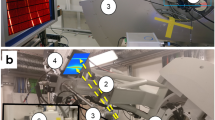Abstract
A newly developed micro-kolsy bar system at the Army Research Laboratory has made it possible to test materials in compression at strain rates greater than 104 s−1. Opening up a new realm for testing of materials at high strain rates. In order to reach these high strain rates, sample diameters must be on the order of tens to hundreds of microns. Fabrication of these micro-samples is done using a femtosecond laser, since the ultrashort pulse width of this laser does not produce any appreciable damage layer. The high strain rate (103–105 s−1) behavior and resulting microstructure of electrodeposited nickel was investigated using this micro-kolsy bar system. The microstructure of the as-deposited and tested samples was examined with electron backscatter diffraction and transmission electron microscopy. Tested samples show evidence of dynamic recrystallization and formation of a large number fraction of high angle, Σ3 boundaries.
Access provided by Autonomous University of Puebla. Download conference paper PDF
Similar content being viewed by others
Keywords
Electrodeposition of metals is capable of producing thin films with microstructures that can vary from ultrafine grained to nanocrystalline grain sizes [1]. Due to the thickness of these films, determination of mechanical properties is usually limited to nanoindentation or other small scale quasi-static testing. This leaves a lack of information for these materials at high strain rates. This information can now be determined using the newly developed micro-kolsky bar system at the Army Research Laboratory [2]. The micro-scale diameter and thickness of the samples needed for this system allow strain rates higher than 103 s−1, even up to 106 s−1 if the samples are small enough [3]. The data presented here will take advantage of the reduced size of this micro-kolsky bar system to investigate the dynamic behavior of electrodeposited nickel foils.
Nickel films were deposited onto a copper substrate submerged in a bath containing nickel salts and appropriate buffer chemicals. To obtain ultrafine grain sizes, deposition occurred by using a current of 300 mA that was pulsed on and off at 5 and 20 ms intervals respectively [4]. The electrodeposited nickel film was removed from the copper substrate and mechanically polished to a final thickness of 150 μm. Using a femtosecond laser, 300 μm diameter cylinder samples were machined out of this film. The pulse width of this laser, 150–200 fs, is so short that it is capable of ablating without inducing damage in material surrounding the incident spot [5]. These samples were tested on the micro-kolsky bar system to strain rates of 103–105 s−1 using steel bars with diameters of 0.790 and 3 mm. Gratings on the input and output bars were used to measuring the strain through interferometry [2]. The microstructure of the samples, both before and after testing, was determined by first performing through thickness cross-sections of the as-deposited and recovered samples, this polishing was done using a Leica TIC 3X ion polisher at 8 kV, 2.2 mA. Then using an FEI Nova Nanolab 600 focused ion beam, the microstructure was imaged using both ion channeling and electron back-scatter diffraction (EBSD).
Figure 20.1 below shows an overview of the results from one of the nickel samples. A scanning electron microscope (SEM) image of the tested sample is shown in Fig. 20.1a, the cross-section of this sample shows that the sample thickness has decreased to 83 μm from the initial thickness of 150 μm, giving a total strain value of 0.44. This total strain value is close to what is observed in the stress-strain curve shown in Fig. 20.1b. The plot also shows that the dynamic yield strength at 8% true strain is 1056 GPa when tested at a strain rate of 105 s−1. Figure 20.1c shows a series of ion channeling images stitched together to show the entire thickness of compressed sample. This image shows that the grains are more refined near the cylinder surfaces and are bigger and elongated near the sample center. The EBSD scan shown in Fig. 20.1d is taken from near the surface, in the small grain region. Analysis of the misorientations in this EBSD scan showed that there is a higher percentage of boundaries near the Σ3 type.
Utilizing the micro-kolsy bar and micrometer scale samples, it is now possible to reach strain rates higher than the 103–104 s−1 achieved during traditional kolsky bar tests. This system has been applied to electrodeposited nickel as a way better determine the full range of mechanical behavior from this metal foil.
References
Kumar, K.S., Suresh, S., Chisholm, M.F., Horton, J.A., Wang, P.: Deformation of electrodeposited nanocrystalline nickel. Acta Mater. 51, 387–405 (2003)
Casem, D.T., Grunschel, S.E., Schuster, B.E.: Normal and transverse displacement interferometers applied to small diameter Kolsky bars. Exp. Mech. 52(2), 173–184 (2012)
Casem, D.T., Ligda, J.P., Schuster, B.E., Mims, S.: High-rate mechanical response of aluminum using miniature Kolsky bar techniques. Dyn. Behav. Mater. 1., Springer International Publishing, 147–153 (2018)
Schüler, K., Philippi, B., Weinmann, M., Marx, V.M., Vehoff, H.: Effects of processing on texture, internal stresses and mechanical properties during the pulsed electrodeposition of nanocrystalline and ultrafine-grained nickel. Acta Mater. 61(11), 3945–3955 (2013)
Chichkov, B.N., Momma, C., Nolte, S., von Alvensleben, F., Tunnermann, A.: Femtosecond, picosecond and nanosecond laser ablation of solids. App. Phys. A. 63, 109–115 (1996)
Author information
Authors and Affiliations
Corresponding author
Editor information
Editors and Affiliations
Rights and permissions
Copyright information
© 2019 The Society for Experimental Mechanics, Inc.
About this paper
Cite this paper
Ligda, J.P., Casem, D., Murdoch, H. (2019). Microstructure Characterization of Electrodeposited Nickel Tested at High Strain Rates. In: Kimberley, J., Lamberson, L., Mates, S. (eds) Dynamic Behavior of Materials, Volume 1. Conference Proceedings of the Society for Experimental Mechanics Series. Springer, Cham. https://doi.org/10.1007/978-3-319-95089-1_20
Download citation
DOI: https://doi.org/10.1007/978-3-319-95089-1_20
Published:
Publisher Name: Springer, Cham
Print ISBN: 978-3-319-95088-4
Online ISBN: 978-3-319-95089-1
eBook Packages: EngineeringEngineering (R0)





